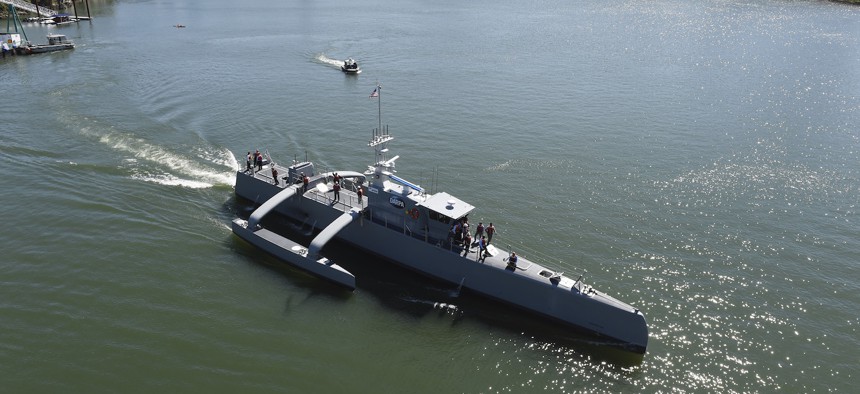
Sea Hunter, a class of unmanned ocean-going vessel gets underway on the Willamette River following a christening ceremony in Portland, Ore., April 7, 2016 John F. Williams/Navy
Acting Navy Secretary: We Need More than 355 Ships, and That’s Not Even Counting Robot Vessels
The Navy needs more human-crewed ships…and more unmanned vessels, than previously thought.
You can’t get to a 355-ship Navy by substituting autonomous vessels for more expensive manned ships, Acting Navy Secretary Thomas Modly said this week. But Modly affirmed that autonomy was going to play a growing role in the Navy’s future and that the service needs to begin experimenting with integrating self-driving ships into the fleet as soon as possible.
Addressing lawmakers on the House Armed Services Committee on Thursday, and the Brookings Institution on Friday, Modly pushed back against the Trump administration’s three-year-old policy of aiming for a 355-ship fleet. The number came from a 2016 force structure assessment that called for 355 ships of then-existing types. Modly calls that number low and outdated. The Navy has recently undertaken a new integrated force structure assessment, looking out to threats ten years into the future, particularly an acceleration of China’s large shipbuilding capacity. The ultimate number of ships the Navy will need in 2030 “actually ended up increasing. But the mix is different,” he told lawmakers.
On Friday, Modly said that the new assessment will reduce its emphasis on large surface combatants, like destroyers. “You will see that number come down in favor of small, highly-capable surface combatants like the frigate.”
But could unmanned ships like the Sea Hunter get the Navy closer to that magic number? Not exactly, said Modly. “If you include unmanned, the number is like 435 with unmanned in there. It’s like 390 without unmanned in there,” meaning with only manned ships.
James Bellingham, Director of the Center of Marine Robotics at the Woods Hole Oceanographic Institution, said in an email that an autonomous vessel “would not have the capability of a manned naval vessel. They would be different. Without humans to fix things, reliability would be a particular problem. But they would be a lot less expensive, more expendable.”
Modly said the Navy is looking to acquire two Sea Hunters, large surface unmanned vessels, this year. The number of large unmanned surface vessels in the future fleet is “still in flux,” he said. “I’m totally comfortable with them being in flux because, frankly, we don’t have any right now. So whether we wind up with 45 of something...or 50 or 75 of something, we don’t know. It’s sort of irrelevant. We know we have to start moving down the path to unmanned and figure out how that will work,” in terms of future concepts of operation and fleet configuration.
Leidos, maker of the Sea Hunter, is spending its own money to make the ghost ship more capable, better able to handle a wider variety of missions. Today, the autonomous systems aboard the Sea Hunter can adhere to International Regulations for Preventing Collisions at Sea, or COLREGs, while also performing a mission like surveying. The ship can even make some rudimentary decisions when it encounters another ship, said Bob McCummins, the Ocean Electronic Systems manager for Leidos’s Maritime Systems Division. “We identify the risk of collision, then we determine the situation that we’re in, based on COLREGs. Are we going to cross somebody? Are we going to be head on? … Then the autonomy determines what role we’re in. Should we be in a stand-on role, or a give-way role? And what do we do?...Not everybody obeys the rules of the road on the ocean. Then we have to determine, are they in a noncompliant COLREGs behavior?”
Once the autonomous ship deals with the other vessel, it can return to what it was doing. Leidos is now self-funding an effort to show that the vessels can do hydrographic surveying, essentially using multibeam sonar to map the ocean floor. The hope is also to show, within the next 12 to 18 months, that the vessel can process that data onboard, rather than collect it and send it back to port for human analysis.
The Sea Hunter was originally intended to trail very quiet diesel-powered submarines around the ocean. Some former defense senior leaders, such as former Defense Department Deputy Secretary Bob Work, have suggested that it could also be outfitted with missiles to defend the fleet or serve as a type of attack ship. The most recent budget request indicates that sort of experimentation isn’t likely this year. While there’s an increase in funds for the large unmanned surface vehicle, there isn’t an ask for a vertical launch system to integrate onto one of the vessels, even for experimentation.
Said Modly, “We have to really accelerate our investment in unmanned platforms...trying to do it at a reasonable pace so we can understand how these technologies might work, and, more importantly, how they might operate together. Without having the platforms it's very difficult for us to do that type of testing… We are proceeding at a somewhat cautious pace. We need to start experimenting with concepts.”
Even if autonomy doesn’t exactly help the Navy cut back on the number of manned ships it has or wants (according to current plans), it will still play a big role in the future of maritime security.
In ten years, Bellingham said, “We will see the perception software approaches and skills [companies are developing] for consumer products [going toward] the marine environment. So our visual systems will be automated; our radars will be increasingly sophisticated; sonar will be transformed; and our at sea systems increasingly networked to offboard sensors. You might expect that there will be substantial commercial investment that will drive technology development just as much, maybe more, than defense funding.”







